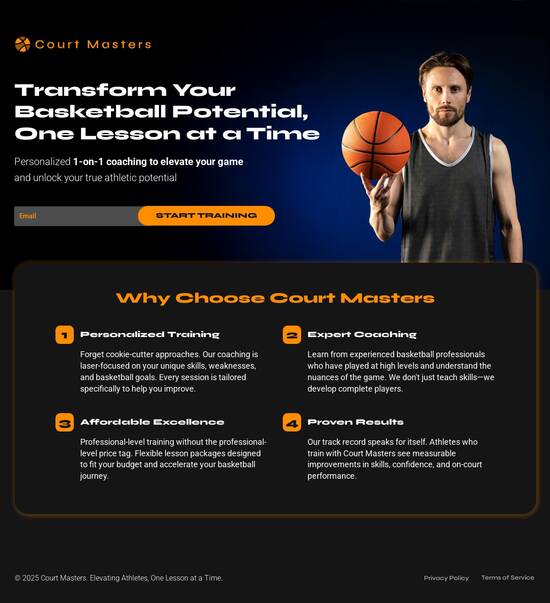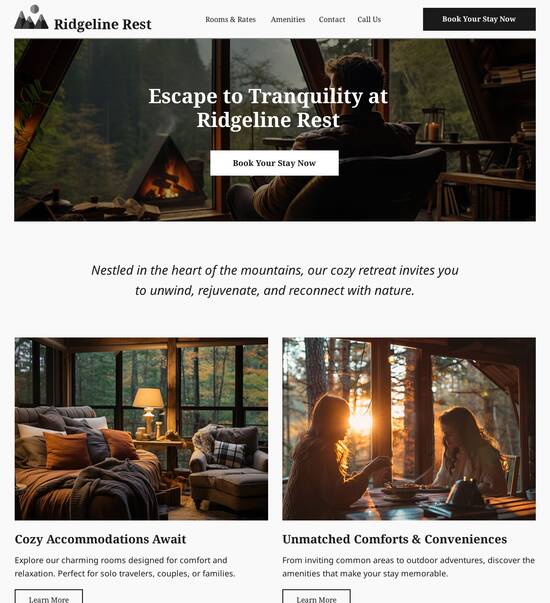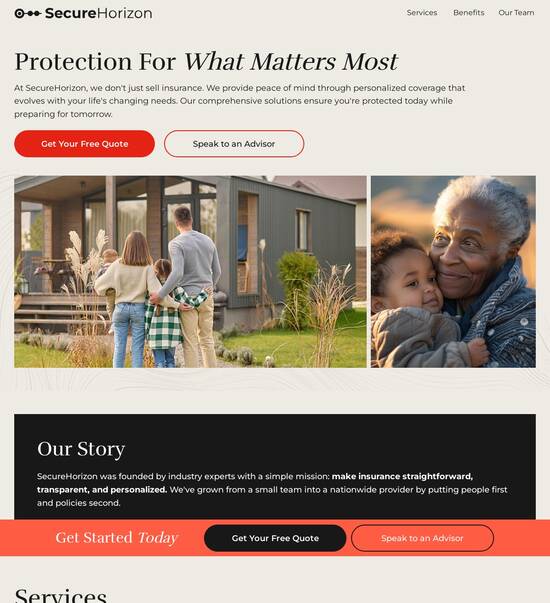
HTML/CSS optimized seminar page template
Explore Similar TemplatesAbout template
Supercharge your seminar page with HTML/CSS for outstanding performance! Learn more today.
Recommended templates

Easy to build without coding
With the intuitive drag-and-drop builder, anyone on your team can create high-converting pages without any knowledge of code or design. Make enhancements to your landing page with custom widgets using Javascript, HTML/CSS, or third-party scripts.

Multiple layouts for any industry and goal
Select from 500+ landing page layouts built to boost conversions across industry-specific scenarios. Customize them by adjusting fonts, adding images, and generating on-brand content with the AI assistant. Quickly scale with Instablocks® and Global Blocks that you can save, reuse, and update globally.

Loads fast and looks polished on any device
Every template is responsive, which means they present professionally on any device and load blazingly fast with our Thor Render Engine. You can also power them up with Google AMP technology to deliver an unparalleled mobile experience and drive higher conversions.

Robust analytics & experimentation
Get real-time updates and reporting across all your devices, showing the number of visitors, conversions, cost-per-visitor, and cost-per-lead. Launch AI-powered experiments, run A/B tests, and use heatmaps to analyze user behavior, then optimize your landing page to maximize conversions.







Easy to build without coding
With the intuitive drag-and-drop builder, anyone on your team can create high-converting pages without any knowledge of code or design. Make enhancements to your landing page with custom widgets using Javascript, HTML/CSS, or third-party scripts.
Multiple layouts for any industry and goal
Select from 500+ landing page layouts built to boost conversions across industry-specific scenarios. Customize them by adjusting fonts, adding images, and generating on-brand content with the AI assistant. Quickly scale with Instablocks® and Global Blocks that you can save, reuse, and update globally.
Loads fast and looks polished on any device
Every template is responsive, which means they present professionally on any device and load blazingly fast with our Thor Render Engine.
Robust analytics & experimentation
Get real-time updates and reporting across all your devices, showing the number of visitors, conversions, cost-per-visitor, and cost-per-lead. Launch AI-powered experiments, run A/B tests, and use heatmaps to analyze user behavior, then optimize your landing page to maximize conversions.
All the features you need to build lead-generating landing pages
Explore more featuresLearn how to build top-performing landing pages for any goal
FAQs
Leading the way in building high-performing landing pages





Mastering Instapage for successful landing page optimization
Effective landing page optimization is critical for improving conversion rates and ensuring your digital marketing efforts yield a high ROI. Instapage serves as the most powerful platform in this realm, offering versatile tools necessary for businesses across various verticals, including marketing, education, and financial services. This guide will walk you through the essential steps you need to take advantage of Instapage’s features.
Understanding Instapage’s unique value proposition
Instapage’s all-in-one solution equips marketing teams with everything necessary to enhance their online campaigns. Whether you're working within business services or educational institutions, the platform's user-friendly interface provides access to numerous high-converting templates and lead generation tools.
- Quick deployment of landing pages: Instapage allows users to select from over 100 customizable templates to launch high-converting pages effortlessly.
- Built-in A/B testing: Evaluate multiple versions of your landing pages to maximize performance through data-driven decisions.
- Comprehensive analytics: Utilize the platform’s analytics dashboard to delve into visitor behaviors and track key performance metrics.
Setting up your first landing page with Instapage
Starting with Instapage is a straightforward process. Here’s how to set up your first landing page:
- Choose a template: Browse the library of templates tailored for different objectives such as lead generation, product launches, or event registrations.
- Customize elements: Modify text, images, and lead forms according to your campaign needs without any coding requirements.
- Publish and track: Once satisfied, publish your landing page and monitor its performance using Instapage’s built-in analytics tools.
Optimizing your landing pages for conversions
To ensure that your landing pages yield the best results, focusing on optimization is essential:
- Leverage heatmaps: Utilize Instapage's heatmaps to see how users interact with your page and make data-informed adjustments.
- Run A/B tests: Regularly experiment with different versions of your landing page to identify which elements drive the highest conversions.
- Utilize personalization: Create tailored experiences for various audience segments by employing dynamic text replacement and targeted messaging.
By incorporating these strategies into your workflow, you enhance the chances of achieving your marketing goals.
Utilize Instapage to empower your marketing campaigns and watch your conversions soar!
Ready to take your marketing efforts to the next level? Start your journey with Instapage today for effective landing page optimization and maximize your ROI.
Optimizing engagement: leveraging HTML/CSS for an effective seminar page template
Understanding the importance of a seminar page template
Landing pages play a crucial role in digital marketing strategies. They are designed to convert visitors into leads and ultimately customers by effectively communicating the value of a product or service. A seminar page template serves as a dedicated landing page that highlights all relevant information about an event, thereby enhancing the user's experience and increasing conversion rates.
Creating a dedicated seminar page is essential for boosting participation and engagement. This focused approach helps in presenting information clearly, tracking registrations, and gathering feedback. Ultimately, on such pages, visitors can easily find the information they need to make an informed decision, which directly correlates with higher conversion rates.
When designing a seminar page, it is important to consider the target audience. Tailoring the content to meet the needs of professionals versus beginners can significantly enhance engagement. For instance, professionals might appreciate in-depth insights and expert-level details, while beginners may benefit more from simplified explanations and step-by-step guides.
Key features of an HTML/CSS optimized seminar page template
An optimized seminar page template is characterized by several key features that enhance user experience and engagement. One of the most important aspects is responsive design. With users increasingly accessing content via mobile devices, ensuring that the seminar page is mobile-responsive is essential. Techniques such as media queries in CSS help in adjusting the layout to fit various screen sizes, enabling a seamless experience on all devices.
Utilize CSS frameworks like Bootstrap for streamlined responsive design.
Test the design across multiple devices to ensure adaptability.
Another vital feature of an effective seminar page is the seamless integration of multimedia elements. Incorporating images, videos, and audio can make the presentation dynamic and engaging. However, it is crucial to follow best practices regarding media placement and loading times to keep the page fast and user-friendly.
Compress images and videos to enhance loading speeds.
Use lazy loading techniques for better performance.
Interactive features also play a significant role in boosting engagement. Incorporating registration forms and feedback options allows users to interact easily with the seminar offerings. Additionally, enhancing interactivity through JavaScript—for example, adding countdown timers—can create a sense of urgency and keep users engaged.
Finally, maintaining a clean code structure is fundamental. A well-organized HTML layout not only improves readability and developer collaboration, but it also significantly impacts SEO performance. Commenting code and using documentation consistently can ease maintenance and help future developers understand your layout.
Benefits of using HTML/CSS in seminar page development
Utilizing HTML/CSS for seminar page development offers various benefits. Firstly, it provides a cost-effective solution compared to third-party services, enabling teams to create customized pages without incurring extra expenses. When organizations develop in-house capabilities through these projects, they empower their teams with valuable skills that enhance future projects and overall digital marketing strategies.
Secondly, the flexibility for customization allows organizations to tailor designs to fit their brand identity accurately. CSS frameworks give marketers a broad spectrum of design options without the need for coding skills, fostering creativity while maintaining efficiency.
Use CSS Grid and Flexbox for advanced layout capabilities.
Adapt template designs to reflect brand colors and typography.
Additionally, an HTML/CSS optimized seminar page enhances user experience by streamlining navigation. Ensuring easy access to information, simple page load times, and intuitive design contributes positively to users’ perception of the seminar, ultimately increasing trust and conversion rates.
Targeting a diverse audience: beginners vs. professionals
Seminar page design should cater to diverse audience segments, particularly beginners and professionals. For beginner users, adapting the content is crucial. Simplifying processes with tutorials and guided setups helps demystify the information they may find overwhelming. This could include easily accessible FAQs and user-friendly documentation that empowers them to navigate the pages independently.
Provide visual aids and tutorial videos for first-time users.
Create a structured path for users to learn and progress.
On the other hand, advanced users may seek more sophisticated features on a seminar page. Employing advanced coding techniques can usher in richer experiences, catering to their needs for deeper insights. Additionally, developing personalization options for returning users can increase engagement, making them feel valued and understood.
Step-by-step guide to setting up your seminar template
Setting up a seminar template involves several crucial steps. Start with a preliminary setup, where selecting the right HTML/CSS framework is essential. Frameworks like Bootstrap and Foundation can offer grid systems and pre-designed components, accelerating your development process. Following this, establish your initial configurations and maintain a logical file structure for ease of use.
Next, focus on designing the layout. Utilizing CSS Grid and Flexbox will enable you to craft a modern, dynamic layout. Experiment with different coloring schemes and typography that resonate with your brand persona. Vibrant colors and professional fonts can transform the aesthetic and align with the tone of your seminar.
Ensure typography is legible and contrasts effectively with the background.
Utilize color psychology to engage users according to themes.
Incorporating interactive elements is the next step, such as creating registration forms for attendee sign-ups. Ensure that the forms are simple and accessible. Implementing features like event countdowns and reminders can significantly enhance user engagement, prompting them to follow through with their intentions.
Lastly, testing and optimizing the page is essential prior to launch. Conduct human-centered testing to collect relevant feedback from test participants. Use tools and metrics to measure performance, allowing you to refine your page continually to meet user experiences and marketing goals.
Common challenges and missteps in seminar page design
In the journey of seminar page design, certain common challenges may arise. One significant issue is the tendency to overload the page with information. While providing detailed insights about the seminar is essential, overwhelming users with excessive content can lead to high bounce rates. Strategies such as content prioritization can help facilitate better communication.
Employ clear headings and bullet points to break down complex information.
Create a visually appealing layout that guides user attention.
Another area often overlooked is SEO considerations. An effective seminar page not only attracts users but also ranks well in search engines. Best practices for HTML markup—such as using semantic tags—can significantly improve search visibility. Placement of SEO keywords throughout your content is equally critical, creating a more search-friendly environment when potential attendees look for relevant seminars.
Learner engagement through tutorials and exercises
To enhance learner engagement, it’s helpful to compile resources like tutorials on HTML and CSS basics. These resources can range from beginner-friendly guides to advanced CSS tricks for professionals. Including interactive exercises allows users to practice their newfound skills, reinforcing learning through application.
Encourage users to experiment with their designs using online platforms like CodePen.
Offer quizzes to test understanding of essential concepts.
In addition to self-learning, fostering community involvement opens avenues for feedback and collaboration. Structuring peer reviews can provide valuable insights for both creators and users. Utilizing online forums as spaces for sharing designs and improvements enhances the learning experience—providing different perspectives and approaches.
Future-proofing your seminar page
To ensure the longevity and relevance of your seminar page, staying updated with trends in web development is paramount. Continuous learning is essential for both beginners and experienced professionals alike. As technology and user behavior evolve, seminar pages must adapt accordingly, providing updated content formats that meet changing audience expectations.
Moreover, embracing emerging technologies like AI-based enhancements can lead to user personalization. For instance, adaptive content delivery that recognizes user behavior can optimize the seminar page experience significantly. Exploring opportunities in emerging fields like virtual reality (VR) and augmented reality (AR) can elevate seminar experiences, making them immersive and unforgettable for attendees.
Ready to skyrocket conversions?
Supercharge your ad campaigns with high-performing landing pages
Get started














